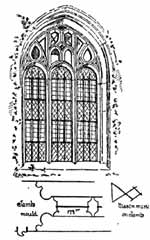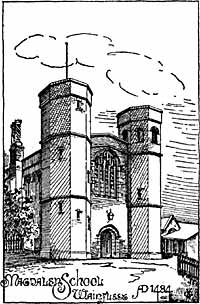
Of the erstwhile "new" church, the nave is aisleless. Originally it had doors on either side. The north door is now built up, and the south door is covered by a porch. It is lighted by six windows, three on either side. These are tall, graceful, three-light windows, well suited to receive painted glass. Each light is 15ft. high by about 18in. wide. The total height is 17ft., and the cill is 10ft. above ground. Several interesting fragments of original glass remain, notably of a crucifixion in the east window in the shape of a chalice, and two small figures of saints.
In the south wall of the chancel are two similar windows, some 2ft. shorter in height, while the same design is adapted to a five-light window at the east end. The light on the north side of this window has been set out fully 2in. wider than the others. One wonders what the mason said when he came to fix the tracery.
The external mouldings are deeply recessed: the jamb and arch mouldings are based on the usual "deep hollow;" the mullions have hollow chamfers and square fillets, and there is an entire absence of cusps. All the work is executed in "water stone," quarried locally. The badge of the Lord Treasurer is conspicuously displayed in carved panels, one on either side of the east window.
The window on the north side of the chancel is entirely different in character, being a remnant of the work of an earlier patron, circa 1377.
A staircase, giving access to the rood-loft and the priest's chamber, is contained in the thickness of the north wall. After being closed up for many years, this has now been opened up again (1915).
After traversing the rood-loft, a continuation stairway in the south wall was reached, leading up to the bell-cote and roof. This detail is mentioned because of its correspondence with the arrangement at the larger church at Tattershall. The corbelling to carry the stairs in the re-entering angle is cleverly contrived.

On the south wall there is a varied assortment of initials and devices, mostly modern. Among them, however, may be noticed well-defined "arrow markings" scratch dials, mason marks, and a sex-foil within a circle. This is said to be one of the twelve consecration crosses, which, toward the end of the 15th century, were ordered to be put within circles, on the outer walls of all churches.
The position of this cross on the face of the central buttress, 6ft. high above ground, is favourable to the supposition, but to my mind there is some doubt about its antiquity. One would like to think that it is a relic of a ceremony which took place on 29th April, 1480, when, according to Torre MS., "a commission was granted to William, Bishop of Dromor to consecrate and dedicate the church within the church of Lambley late wholly rebuilt; and also to grant indulgence, or remission of 40 days to all persons truly contrite and penitent who should keep the anniversary day of this dedication and consecration of the church."
Why an Irish bishop should have been brought in for this occasion is not clear at first sight. But when we are reminded that George Neville, brother of the husband of one of Cromwell's nieces and co-heirs, was Archbishop of York while this new church was in building, and that William Egremont, Bishop of Dromore, was the commissioned suffragan who usually acted for him, it will be seen that it was " all in the family."
St. Wilfrid's, at Kelham,1 is a small village church, "of little interest" to the casual observer, but replete with interest to the archaeologist and the architect.
Previous to the 15th century, a church without side aisles occupied the site, but it was partly cleared away to make room for the present building. As in the previous example, the lower part of the 14th century tower, and probably the 15th century rood-screen (circa 1475) were retained.
The decided preference for deep hollows in all the mouldings, the deep set glass line of the windows, the jamb mouldings, which are the same internally and externally, and the absence of cuspings, are all indications of the Tattershall influence.
The connection between Tattershall and Lambley is obvious, but why should the Tattershall influence be manifest at Kelham?

From Inquisitions post Mortem (p. 86) we learn that "Thomas Fitzwilliam died on Friday next after the Feast of the Nativity of the Blessed Mary 8 Sept. 5 Henry viij [1513] seized of the manor of kelom in his demesne as of fee, which manor is held of the King as of his Duchy of Lancaster."
Matilda Cromwell, daughter and in issue co-heir of the first Baron Cromwell of Tattershall, and therefore the Lord Treasurer's aunt, married, first, Sir W. Fitzwilliam, of Elmley, Ebor., and Plumtree, Notts.
The Renaissance feeling apparent in the capitals and mouldings indicate circa 1500 as the date of erection, and the knowledge that the lord of the manor of Kelham at that time was a direct descendant of the Cromwells, explains why the Tattershall school of craftsmen were employed here.
There is nothing exceptional about the building, and yet the graceful proportions, the simplicity and uniformity of the mouldings, and the excellence of the material and workmanship all combine to make it a model village church.
Its propinquity to the Royalist stronghold at Newark, and the fact that the north door has been pierced with a row of holes to allow of a discharge of musketry from within, show that it played a part in the great siege at the time of the Civil War.

The last building to be brought under notice is Magdalen School, Wainfleet, founded A.D. 1484. Here the traditions and characteristics of the Tattershall influence are paramount. The bricks are laid in irregular old English bond, with diamond patterns formed with vitrified headers; the main front is flanked with polygonal turrets; the staircase is after the manner of Tattershall and Esher Place to the minutest detail, save that the handrail of the staircase is here worked in brickwork; while a comparison of the tracery of the stone window with the churches at Tattershall, Lambley, and Kelham leaves no doubt as to the origin of the design. "Every part of the building and all its details, exhibit the most careful treatment." It is at once a combination and an epitome of the work of its founder, William of Waynflete.
We know, from documents still extant, that the builder was a Tattershall man, and that the superintendence of the work was entrusted to one John Gyger (or Gygour), a Warden of Merton College from 1471 to 1482, who had previously been Warden of Tattershall College during the Lord Treasurer's lifetime, and consequently in close touch with Waynflete throughout the rebuilding period.
The documents referred to are interesting, and throw considerable light on the building methods of the period. I am, therefore, induced to make a somewhat lengthy extract.2
In the first place, there is a letter from John Gygur to the Bishop of Winchester, concerning his chapel and school-house at Waynflete, wherein he says that:— "Harry Alsbreke * * * wol not make you an house of lxx feet of length and xxti fote of brede, to fynde al maner of stuff longyng to the same lesse then xxx"ti pounds and he to fynd al cariage ther to * * * and as for bryke to be had for your scole both Tontoft and John Robinson taryth the comyns of a gentilman that thei trust to have good pennyworthes of and thei beke dayli somewhat comyns and thei doute not but ye schal have brike plenty." Then he goes on to suggest that "the maner of makyng" the school be an " example of sum maner house in your nobyl place of Ascher that may be exemple to hym."
The approximate estimate came very near the mark, for a contract was eventually entered into "on the xxvth day of Aprill, the yere of the r eigne of Kyng Richarde the third the first, whereby "Henry Alsbroke of Tateshall" agreed to carry out the work for "xxv.li. xiiis. iiiid and a gown of cloth or ells vis. viiid for a gown of cloth." The work to be done was clearly specified;—"a flore with a Rofe of Tymber of good herte of ooke conteyning in lengthe lxx foote, and in brede within the walles xxti foote with dores windowes steyres hynches reredoses desks and all other thyngs necessarye that longeth to carpentry werk for a Chapell and Scolehouse * * * the work to be made aftor the patron and facyon of the flore of the chambyr in the Towre on the gate of the maner of Essher:" then follows a detailed list of scantlings, and a stipulation that all the work shall be "wele and warkmanly doon, set up and finesshed."
This contract provides for carpenters' and joiners' work only. In a descriptive account of the school, written in 1785, Mr. Pickburn, the schoolmaster, says:— "The bricks are of a somewhat larger size, better clay and closer texture than those usually made in our neighbourhood. They are supposed (how truly I know not) to have been made in the Isle of Ely, and conveyed hither by water."
After taking all the facts into consideration, I am inclined to think that the "new style" was primarily the outcome of the fertile brain of Bishop Waynflete. The fine monumental brass in Tattershall Church, to a warden of the college whose name is now illegible, would be a fitting tribute to the worth of his coadjutor, John Gygour, who so ably assisted him in carrying out the work.
Whether my conjecture on these points is right or wrong matters little if I have been able to shew that the "new style"—notwithstanding Ruskin's sarcasm about being " confined in its insanity by a straight waistcoat of perpendicular lines"—offers an interesting and fertile field for study. How far it might have developed but for the interruption caused by the Wars of the Roses, "when Patron and Art alike were destroyed," is a subject for speculation. I am sure the benefit would be ours if, instead of devoting all our time and attention to foreign examples and influences, we would spare a little more consideration for some of the less assuming buildings at home.
The paper was illustrated by nearly one hundred photographic lantern slides, prepared by the author, partly from his own negatives, and partly from negatives kindly lent by Mr. W. H. Warsop, of Nottingham, Mr. J. H. Bower, of Crich Common, near Matlock, and Dr. R. C. Stewart, of Narborough.

(1) See Transactions, vol. xvii., 1913, for illustrations.
(2) Life of William of Wayneflete, Bishop of Winchester, by Dr. Chandler, published 1811 by Charles Lambert.
